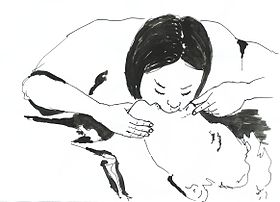| Mouth-to-mouth resuscitation | |
|---|---|
 Mouth-to-mouth insufflation | |
| ICD-9-CM | 93.93 |
| MeSH | D012121 |
Mouth-to-mouth resuscitation, a form of artificial ventilation, is the act of assisting or stimulating respiration in which a rescuer presses their mouth against that of the victim and blows air into the person's lungs.[1][2] Artificial respiration takes many forms, but generally entails providing air for a person who is not breathing or is not making sufficient respiratory effort on their own.[3] It is used on a patient with a beating heart or as part of cardiopulmonary resuscitation (CPR) to achieve the internal respiration.
Pulmonary ventilation (and hence external respiration) is achieved through manual insufflation of the lungs either by the rescuer blowing into the patient's lungs, or by using a mechanical device to do so. This method of insufflation has been proved more effective than methods which involve mechanical manipulation of the patient's chest or arms, such as the Silvester method.[4] It is also known as expired air resuscitation (EAR), expired air ventilation (EAV), rescue breathing, or colloquially the kiss of life. It was introduced as a life-saving measure in 1950.[5]
Mouth-to-mouth resuscitation is a part of most protocols for performing cardiopulmonary resuscitation (CPR)[6][7] making it an essential skill for first aid. In some situations, mouth-to-mouth resuscitation is also performed separately, for instance in near-drowning and opiate overdoses. The performance of mouth-to-mouth resuscitation on its own is now limited in most protocols to health professionals, whereas lay first-aiders are advised to undertake full CPR in any case where the patient is not breathing sufficiently.
- ^ "Definition of mouth-to-mouth resuscitation". Merriam-Webster Dictionary. Retrieved 4 February 2021.
- ^ Tortora, Gerard J; Derrickson, Bryan (2006). Principles of Anatomy and Physiology. John Wiley & Sons Inc.
- ^ "Artificial Respiration". Encyclopædia Britannica. Archived from the original on 14 June 2007. Retrieved 2007-06-15.
- ^ "Artificial Respiration". Microsoft Encarta Online Encyclopedia 2007. Archived from the original on 2004-01-04. Retrieved 2007-06-15.
- ^ Stathis Avramidis, Facts, Legends and Myths on the Evolution of Resuscitation, page 27
- ^ "Decisions about cardiopulmonary resuscitation model information leaflet". British Medical Association. July 2002. Archived from the original on 2007-07-05. Retrieved 2007-06-15.
- ^ "Overview of CPR". Circulation. 112 (24 sup). 2005. doi:10.1161/CIRCULATIONAHA.105.166552.